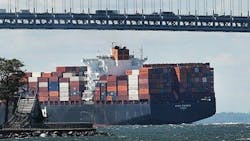Although rates have risen significantly from the historic lows of early 2016, uncertainty for the global container shipping market in 2017 will be uncertain, according to Xeneta, a company that prvides market intelligence platform for containerized ocean freight.
Next year should give “battered shipowners” some reprieve, but structural problems continue to undermine stability the firm says. The reason for this forecast is that “macro-economic and political factors are casting long shadows on the horizon.”
Reviewing 2016 the firm notes that it was a tumultuous year for carriers, defined by low rates, overcapacity and the subsequent collapse of Hanjin. However, the final months of the year saw generally higher short-term rates, with the market average price for 40’ containers on the world’s number one trade route – Far East Asia to North American main ports – climbing from a low of $1164 in April to $1716 by the close of 2016.
The same rates on the number two route – Far East Asia to North Europe – climbed from lows of $791 to $1878 the end of the year.
“Prices rose from Q3 into Q4 before flattening out a little,” comments Xeneta CEO Patrik Berglund, “but the carriers’ position improved significantly from the dire situation they found themselves in early 2016. That said, it had to.
“With the majority of carriers losing money hand over fist last year, the industry simply wasn’t sustainable. And that’s bad news for shippers, as well as the shipowners, as they need optimal reliability in their supply chain. Stability is what all parties desire – built on a foundation of fair rates – but that still looks elusive as we head into 2017.
“However,” he adds, “profit is still the Holy Grail and all parties need to chase the pennies. Whoever achieves the lowest cost base per TEU, while at the same time optimizing their agreements on every single transaction, will emerge as the victors in this ultra competitive landscape. A few dollars here and there on every container can add up to millions in profit for the biggest players.”
So far in 2017, this community reports that the long-term rates that have been locked are high in relation to 2016 – actually closing in on 2015 levels - but the trend is to put the typical January negotiations (when European shippers secure agreements) on hold.
“There’s such uncertainty in the market that shippers are stalling coming to the table, they’re unsure of where they stand,” Berglund states. “The fact that the carriers are prepared to accept this delay shows they believe they’re in a strong position – that prices will continue to develop over the coming months, allowing them to lock in higher rates when talks finally begin. This is a clear indication of positive sentiment from their side.
Material Handling & Logistics is an IndustryWeek companion site within Penton's Manufacturing & Supply Chain Group.
About the Author
MH&L Staff
Find contact information for the Material Handling & Logistics staff: Contact Material Handling & Logistics.
